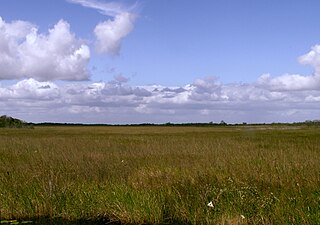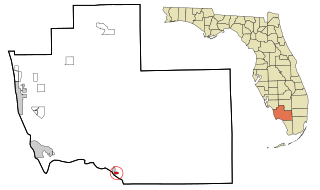Related Research Articles

Collier County is a county in the U.S. state of Florida. As of the 2010 census, the population was 321,520. Its county seat is East Naples, where the county offices were moved from Everglades City in 1962.

The Everglades is a natural region of tropical wetlands in the southern portion of the U.S. state of Florida, comprising the southern half of a large drainage basin within the Neotropical realm. The ecosystem it forms is not presently found anywhere else on earth. The system begins near Orlando with the Kissimmee River, which discharges into the vast but shallow Lake Okeechobee. Water leaving the lake in the wet season forms a slow-moving river 60 miles (97 km) wide and over 100 miles (160 km) long, flowing southward across a limestone shelf to Florida Bay at the southern end of the state. The Everglades experience a wide range of weather patterns, from frequent flooding in the wet season to drought in the dry season. Throughout the 20th century, the Everglades suffered significant loss of habitat and environmental degradation.

Chokoloskee is an unincorporated community and census-designated place (CDP) located at the edge of the Ten Thousand Islands in Collier County, Florida, United States. The population was 359 at the 2010 census. It is part of the Naples–Marco Island Metropolitan Statistical Area.

Everglades City is a city in Collier County, Florida, United States, of which it is the former county seat. As of the 2010 census, the population is 400. It is part of the Naples–Marco Island Metropolitan Statistical Area. The Gulf Coast Visitor Center for Everglades National Park is in Everglades City.

Plantation Island is a census-designated place (CDP) in Collier County, Florida, United States. The population was 163 at the 2010 census. It is part of the Naples–Marco Island Metropolitan Statistical Area.

Everglades National Park is an American national park that protects the southern twenty percent of the original Everglades in Florida. The park is the largest tropical wilderness in the United States, and the largest wilderness of any kind east of the Mississippi River. An average of one million people visit the park each year. Everglades is the third-largest national park in the contiguous United States after Death Valley and Yellowstone. UNESCO declared the Everglades & Dry Tortugas Biosphere Reserve in 1976, and listed the park as a World Heritage Site in 1979, while the Ramsar Convention included the park on its list of Wetlands of International Importance in 1987. Everglades is one of only three locations in the world to appear on all three lists.

Pelican Island National Wildlife Refuge is a United States National Wildlife Refuge (NWR), and part of the Everglades Headwaters NWR complex, located just off the western coast of Orchid Island in the Indian River Lagoon east of Sebastian, Florida. The refuge consists of a 3-acre (12,000 m2) island that includes an additional 2.5 acres (10,000 m2) of surrounding water and is located off the east coast of Florida of the Indian River Lagoon. Established by an executive order of President Theodore Roosevelt on March 14, 1903, Pelican Island was the first National wildlife refuge in the United States. It was created to protect egrets and other birds from extinction through plume hunting.

Cladium is a genus of large sedges, with a nearly worldwide distribution in tropical and temperate regions. These are plants characterized by long, narrow (grass-like) leaves having sharp, often serrated (sawtooth-like) margins, and flowering stems 1–3 m tall bearing a much-branched inflorescence. Like many plants found in wet habitats, it has deeply buried rhizomes that can produce tall shoots with dense canopies.

Big Cypress National Preserve is a United States National Preserve located in South Florida, about 45 miles west of Miami on the Atlantic coastal plain. The 720,000-acre (2,900 km2) Big Cypress, along with Big Thicket National Preserve in Texas, became the first national preserves in the United States National Park System when they were established on October 11, 1974. In 2008, Florida film producer Elam Stoltzfus featured the preserve in a PBS documentary.
Earth systems engineering and management (ESEM) is a discipline used to analyze, design, engineer and manage complex environmental systems. It entails a wide range of subject areas including anthropology, engineering, environmental science, ethics and philosophy. At its core, ESEM looks to "rationally design and manage coupled human–natural systems in a highly integrated and ethical fashion". ESEM is a newly emerging area of study that has taken root at the University of Virginia, Cornell and other universities throughout the United States, and at the Centre for Earth Systems Engineering Research (CESER) at Newcastle University in the United Kingdom. Founders of the discipline are Braden Allenby and Michael Gorman.

The Ten Thousand Islands are a chain of islands and mangrove islets off the coast of southwest Florida, between Cape Romano and the mouth of the Lostmans River. Some of the islands are high spots on a submergent coastline. Others were produced by mangroves growing on oyster bars. Despite the name, the islets in the chain only number in the hundreds.
The Glades culture is an archaeological culture in southernmost Florida that lasted from about 500 BCE until shortly after European contact. Its area included the Everglades, the Florida Keys, the Atlantic coast of Florida north through present-day Martin County and the Gulf coast north to Marco Island in Collier County. It did not include the area around Lake Okeechobee, which was part of the Belle Glade culture.

The Turner River Site is an archaeological site in the Ten Thousand Islands region of Everglades National Park, in Florida. It is listed on the U.S. National Register of Historic Places.

Shark Valley is a geological depression at the head of the Shark River Slough in far western Miami-Dade County, Florida, United States. It is currently part of Everglades National Park. Shark Valley empties into Shark River in the Ten Thousand Islands of Monroe County. Shark Valley characteristically includes sawgrass prairie that floods during the rainy season, hence the name "river of grass"—Pa-Hay-Okee, from the Mikasuki language—for such marshes in the Everglades. Shark Valley features a Visitor Center with educational displays, a park video, an underwater camera and informational brochures. The entrance to Shark Valley is located along Tamiami Trail near the Miami-Dade–Collier County line.

The geography and ecology of the Everglades involve the complex elements affecting the natural environment throughout the southern region of the U.S. state of Florida. Before drainage, the Everglades were an interwoven mesh of marshes and prairies covering 4,000 square miles (10,000 km2). The Everglades is simultaneously a vast watershed that has historically extended from Lake Okeechobee 100 miles (160 km) south to Florida Bay, and many interconnected ecosystems within a geographic boundary. It is such a unique meeting of water, land, and climate that the use of either singular or plural to refer to the Everglades is appropriate. When Marjory Stoneman Douglas wrote her definitive description of the region in 1947, she used the metaphor "River of Grass" to explain the blending of water and plant life.

Shadow Country is a novel by Peter Matthiessen, published by Random House in 2008. Subtitled A New Rendering of the Watson Legend, it is a semi-fictional account of the life of Scottish-American Edgar "Bloody" Watson (1855–1910), a real Florida sugar cane planter and alleged outlaw who was killed by a posse of his neighbors in the remote Ten Thousand Islands region of southwest Florida. It won the National Book Award for Fiction in 2008 and the William Dean Howells Medal in 2010.

The Ten Thousand Islands National Wildlife Refuge is located in Southwest Florida in Collier County, between Marco Island and Everglades City, Florida. The refuge was first established in 1996 and covers 35,000 acres of the Ten Thousand Islands. The refuge includes both fresh and saltwater, and protects a large area of mangrove forest.
Schuchart/Dow is a Seattle-based builder and remodeler. Past projects by the company have included urban condominiums, single-family residences, island retreats and vacation properties. The firm recently constructed the first rammed earth structure in the Hawaiian Islands, which was designed by Olson Kundig Architects.

The Everglades Wilderness Waterway is a 99-mile navigable recreational waterway route within Everglades National Park, also known as Marjory Stoneman Douglas Wilderness. It includes many interconnecting creeks, rivers, lakes and inner bays that are navigable by shallow draft powerboat, kayak or canoe. The official Wilderness Waterway route is 99 miles long, but a traveler can use various additional route options to greatly extend or slightly shorten the trip.
Lostmans River is a river located in Everglades National Park, Monroe County, Florida. It flows into the Gulf of Mexico. It is a part of the Ten Thousand Islands chain.
References
| This article related to a river in Florida is a stub. You can help Wikipedia by expanding it. |